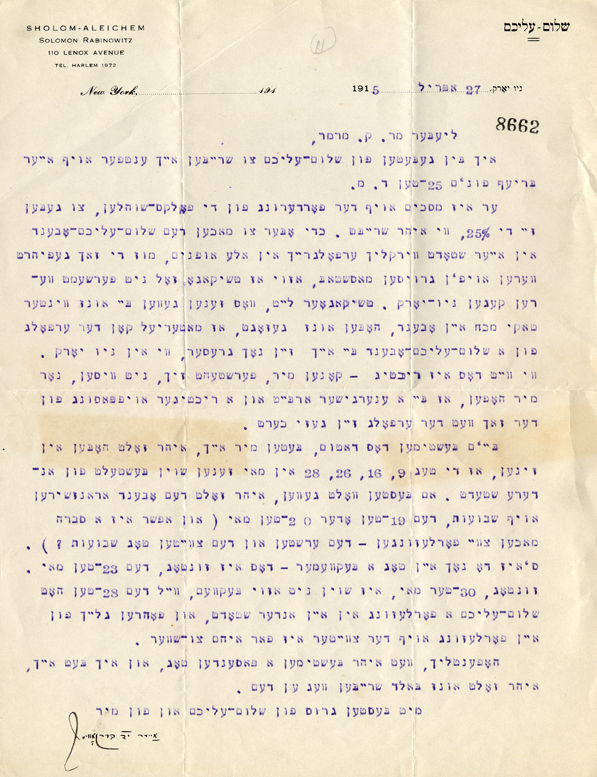Di gantse velt af a firmeblank: The World of Jewish Letterheads
Assemble the letterheads of Jewish organizations, institutions, and individuals in Europe, North and South America, and Palestine from the 1890s to the eve of World War II in 1939 and you have a portrait of the Jewish world: transnational; diverse in language, political, and religious orientation; and flourishing.
Di gantse velt af a firmeblank (The Whole World on a Letterhead) is an experiment in building that portrait. Here, we hope to bring you several times a month, a different example of letterhead from a single collection in the YIVO Archives, the Papers of Kalman Marmor.
Marmor, a Yiddish writer and cultural activist, was born October 11, 1879 in Mayshigola, Vilna Gubernia (today Maišiagala, Lithuania). In 1906, he settled in the U.S. Initially active with the Labor Zionist movement, he later became a Communist. He was an organizer of the 1937 World Yiddish Culture Congress, cultural director of the International Workers Order, and a contributor to the Communist Yiddish newspaper, Morgn Frayhayt. Between 1933 and 1936, he lived in Kiev, where he worked at the Institute of Jewish Proletarian Culture and prepared scholarly editions of the work of American Yiddish poets and writers. During Stalin’s Great Terror, the Institute was liquidated, and much of its leadership was arrested and executed. Marmor, an American citizen, returned to the U.S. He died in Los Angeles in 1956.
His papers at YIVO contain several thousand letters from the turn of the 20th century to the 1950s. He had an astonishingly diverse array of correspondents, not limited to Zionist and Communist activists.

Letter from Yitskhak Dov Berkowitz in New York to Kalman Marmor in Chicago, April 27, 1915. (YIVO RG 205, Folder 106)
Berkowitz writes on behalf of his father-in-law, Sholem Aleichem, about organizing a “Sholem Aleichem evening” in Chicago. “However, in order to make such an event in your city truly successful in every aspect, it must be carried out on a large scale, so that Chicago won’t need to feel it hasn’t measured up to New York.” In fact, Chicagoans have passed on the tip that there is even the potential for Chicago upstaging New York.
Yitskhak Dov Berkowitz (1885-1967), a Hebrew and Yiddish writer, was Sholem Aleichem’s editorial assistant and manager as well as a relative. This was Sholem Aleichem’s second sojourn in the United States. Following a trip to New York in 1906-1907, when two plays of his were staged in the Yiddish theater and flopped, he had returned to Europe. But World War I drove him back to America.
Here, Berkowitz suggests several dates in the spring of the following year, around Shavuoth, for his father-in-law’s trip to Chicago. Little did he or his correspondent know that by then the writer would be dead: Sholem Aleichem died in New York on May 13, 1916. Berkowitz became his literary executor, as well as a leading figure in his own right on the Hebrew literary scene in both America and Palestine, where he moved in 1928.
Series curated by Roberta Newman; Images digitized by Vital Zajka.